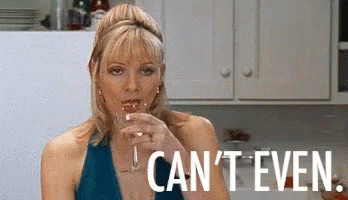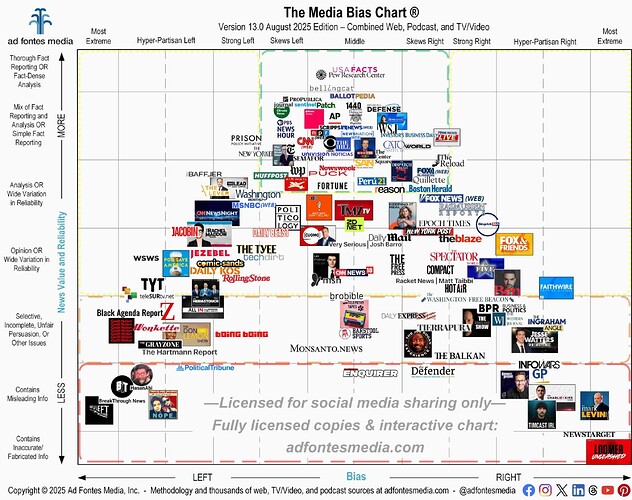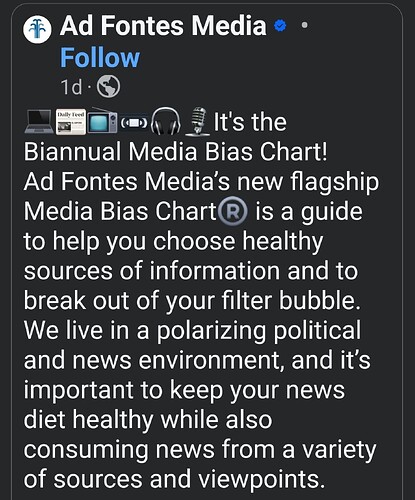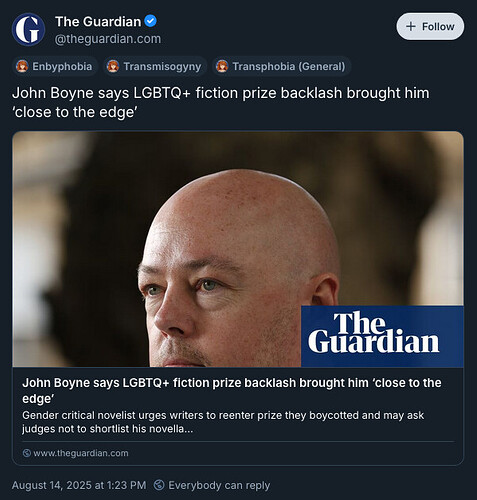“Focus his resources on the people who make it unsafe,” eh… I can only imagine what he means by this clearly objective and not at all racist statement. Unless he is referring to the federal troops currently making the area unsafe?
![]()
The flagship Media Bias Chart® is a static JPG or PDF infographic that includes sources from various types of media all in one image, and it’s released only twice per year, in January and August. During the rest of the year, we produce monthly charts that are specific to web/print, podcast/audio and TV/video.
With each chart release, the questions we get most often are about which sources are the “best” — the least biased and most reliable to give you verifiable facts. In order to help you determine that at a glance, the Media Bias Chart® is divided into different colored sections.
Sources in the green section of the chart are the fruits, vegetables, and lean protein — the ones we’ve found to provide fact-based, reliable and minimally biased or balanced information for a healthy news diet.
Sources in the orange and red sections are the candy or junk food — the ones we’ve found to contain unfair, false, or misleading information and/or extreme bias. They can be very satisfying to consume but are generally unhealthy, especially if you’re having candy for breakfast, lunch and dinner.
Sources in the yellow section are like bread and pasta — they can be heavy with analysis and opinion, and they will fill you up with information, but one cannot live on bread alone. We suggest caution and additional inspection of sources in the yellow section, for various reasons.
The content may vary widely in reliability (for example, some episodes of a podcast may be highly reliable and other episodes less so). Or the source may have high levels of bias even though their content is generally reliable. So remember, use caution when consuming information from sources in the yellow section of the Media Bias Chart®.
To maintain a healthy news diet, we encourage you to try out the sources in the green box, even if you haven’t consumed them before. Relying on these sources for information regularly will make you a healthy and informed media consumer.
Some of them have a bias to your opposite political side, because the green box includes sources with a “skews left” or “skews right” bias. Being exposed to reliable, but minimally biased content from the “other side” can help keep you from getting stuck in a filter bubble. And it can help you to have meaningful conversations with friends and family who may not agree with you politically.
This flagship chart contains a total of 132 sources: 92 from web/print, 20 podcast/audio and 20 TV/video programs. It includes a mix of national, international and local sources. We know it can be difficult to see the individual logos, so a list of all sources on the flagship chart is available here.
Keep in mind that these are only a sample of the thousands of sources our team has fully rated (2,690+ websites, 800+ podcasts, and 800+ TV/video programs!). We’ll be back with monthly charts for web, podcast and TV/video sources in September.
Ugh, this worthless chart again. For a world where The New Yorker and CNN News Night are strong left but the damn Cato Institute and Daily Mail are barely right of center. ![]()
I have a suspicion the chart skews right. (I note that it lists BB as “strong left.” I have to wonder if that is still applicable.)
Well, iirc, all but Rob were left handed. ![]()
Right?
Even the chart is both-sides-ing it. The analysis of bias is itself biased by trying to force balance and symmetry where it doesn’t exist.


I’m a bit skeptical of these kind of charts to start with, but when they list TYT to the Left of BoingBoing and Jezebel…

I’ll admit, I don’t have much knowledge of HasanAbi, but my impression is he’s not that radically left (except maybe in comparison to more centrist content. But then, I’ve lurked/hung out in straight-up communist and/or anarchist Twitch channels so maybe my viewpoint is off?)
I’d say HasanAbi is a legitimate leftist, in the same category as Bernie and AOC. Which is to say, by American standards. He’s certainly well to the left of his uncle.
I can agree with that, for sure! ![]()
When it comes to “the Left,” it feels like the more I learn, the more there is yet to know, and I never feel like I fully understand it all. ![]()



